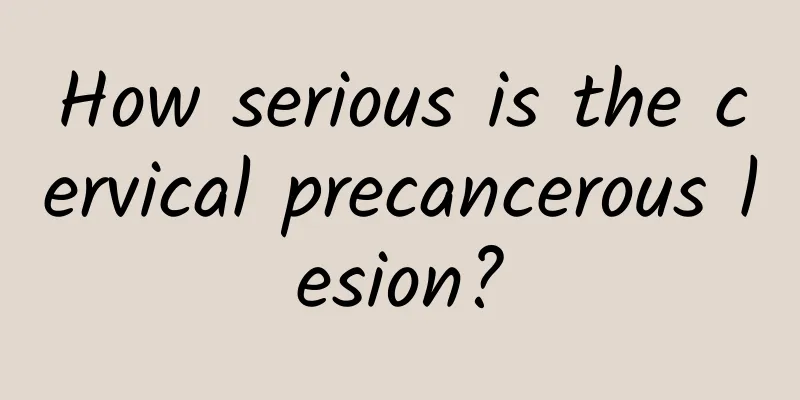How serious is the cervical precancerous lesion?

|
The severity of cervical precancerous lesions depends on the type and grade of the lesions. Some lesions may develop into cervical cancer and require timely intervention. Cervical precancerous lesions are usually divided into low-grade and high-grade. Low-grade lesions may regress on their own, while high-grade lesions have a higher risk of cancer. Treatment methods include regular follow-up, drug therapy, and surgical intervention. 1. Causes of cervical precancerous lesions Cervical precancerous lesions are mainly related to human papillomavirus (HPV) infection, especially high-risk HPV. Other factors include a weakened immune system, long-term use of oral contraceptives, smoking, and multiple sexual partners. Genetic and environmental factors may also increase the risk of disease. After HPV infection, the virus may lurk in cervical cells for a long time, causing abnormal cell proliferation and the formation of precancerous lesions. 2. Diagnosis and grading of cervical precancerous lesions Precancerous lesions of the cervix are initially screened through cervical cytology tests such as TCT and HPV testing, and the diagnosis depends on colposcopy and cervical biopsy. The lesions are divided into low-grade squamous intraepithelial lesions (LSIL) and high-grade squamous intraepithelial lesions (HSIL). LSIL is usually associated with HPV infection and may disappear on its own; HSIL has a higher risk of cancer and requires active treatment. 3. Treatment of cervical precancerous lesions Low-grade lesions can be followed up regularly to see if the lesions have subsided. High-grade lesions require active treatment, and common methods include: Drug treatment: such as interferon, immunomodulators, etc., to enhance the body's immunity and inhibit viral replication. Physical therapy: such as laser therapy and cryotherapy, which directly remove diseased tissue. Surgical treatment: including LEEP and cold knife conization, suitable for patients with high-grade lesions or suspected cancer. 4. Prevention and life advice The key to preventing cervical precancerous lesions is regular screening and HPV vaccination. It is recommended that women undergo regular cervical cytology examinations starting at age 21, combined with HPV testing after age 30. Avoid smoking, reduce the number of sexual partners, use condoms, etc. to reduce the risk of infection. Eat more foods rich in vitamins C, E and folic acid, such as citrus fruits, nuts and green leafy vegetables, to enhance immunity. Although cervical precancerous lesions have certain risks, early detection and standardized treatment can effectively control the condition and reduce the probability of cancer. Regular screening and a healthy lifestyle are the key to prevention, and patients should actively cooperate with doctors to avoid worsening of the disease. |
<<: Symptoms of abnormal increase in vaginal discharge
>>: Vulva does not itch but leucorrhea is abnormal
Recommend
What can't you eat if you have adenomyosis?
Patients with adenomyosis should avoid high-fat f...
What foods are good for preparing for pregnancy with uterine fibroids? What foods are taboo to eat with uterine fibroids?
What foods are good for preparing for pregnancy w...
What medicinal wine can treat uterine fibroids? Can medicinal wine eliminate uterine fibroids?
What medicinal wine can treat uterine fibroids? C...
Six major reasons for infertility caused by artificial abortion
Abortion is a very dangerous operation and will c...
Women should pay attention to the causes of cervical hypertrophy
In recent years, the incidence of cervical hypert...
Symptoms of hyperprolactinemia
Hyperprolactinemia refers to a syndrome caused by...
Is it safe to have painless induced abortion after pregnancy?
Many women often choose many methods to abort the...
When does uterine fibroids require surgery? What are the contraindications after uterine fibroid surgery?
With the accelerated pace of life, modern women a...
Women should learn more about the prevention of vulvar leukoplakia
Vulvar leukoplakia is a common disease among wome...
What should I do after uterine fibroid surgery? What should I pay attention to after uterine fibroid surgery?
What are the precautions after uterine fibroid su...
Will there be pain after painless abortion?
Will there be pain after a painless abortion? Pai...
What are the symptoms of primary cervical erosion?
What are the symptoms of first-degree cervical er...
Is a 2.0 cm ovarian cyst serious?
Is a 2.0cm ovarian cyst serious? An ovarian cyst ...
Is ectopic pregnancy a genetic disease?
Is ectopic pregnancy a genetic disease? Genetic d...
Study on the slimming boiled egg breakfast: nutritious and fat-reducing
[Key points]: A day's plan begins in the morn...









